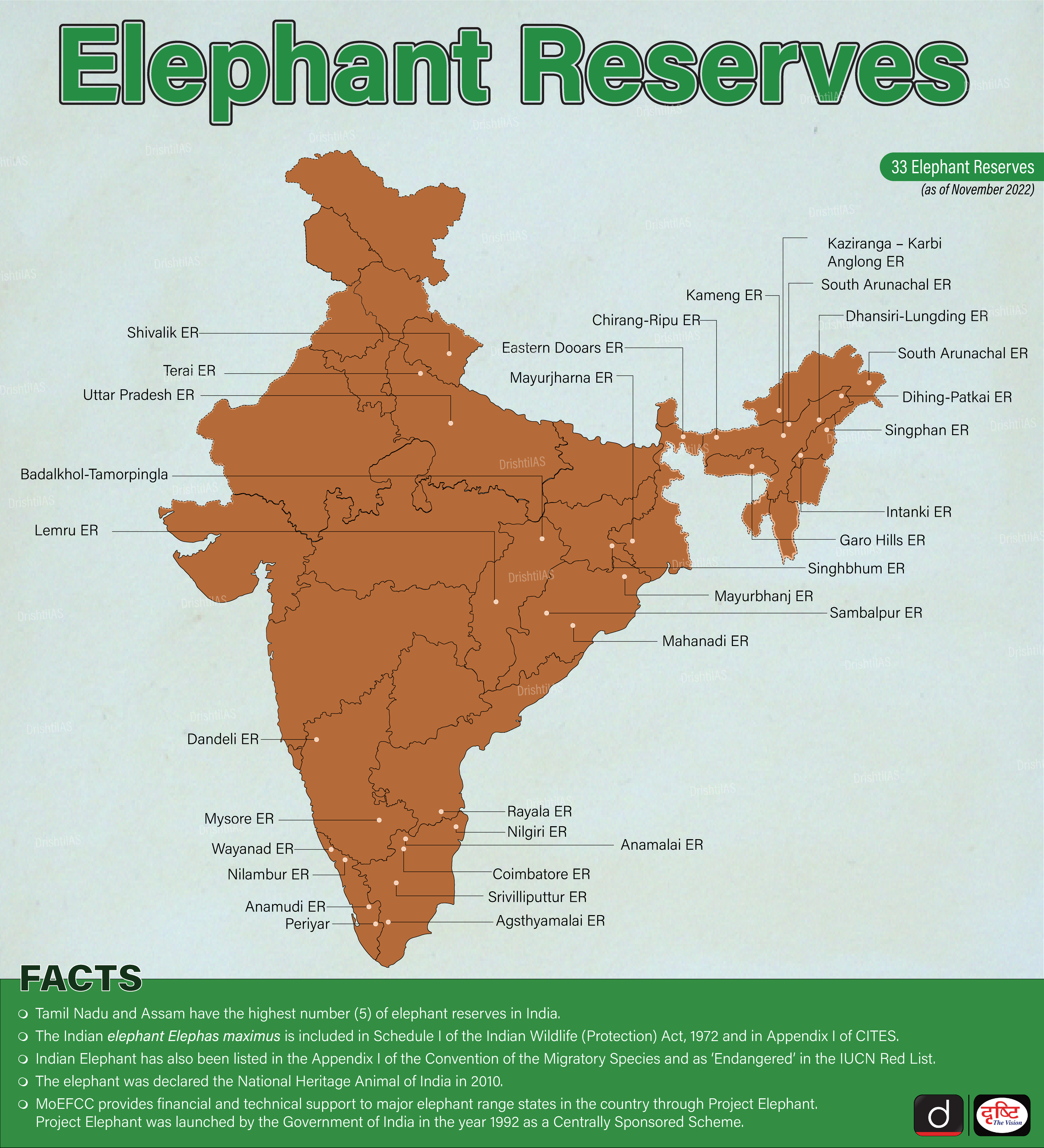DNA Profiling of Elephants | 25 Mar 2023
Why in News?
While celebrating the 30 years of ‘Project Elephant’, the MoEF&CC has announced the completion of the DNA (Deoxyribonucleic Acid) Profiling of 270 elephants, aiming at ensuring better protection.
What is the Project?
- The DNA profiling was started in August 2022 for Gaj Soochna Mobile Application for forest officials.
- DNA profiling is the process where a specific DNA pattern, called a profile, is obtained from a sample of bodily tissue.
- The DNA profiling will act as the ‘Adhaar card of captive elephants’.
- The captive elephants had earlier been chipped electronically, but the method was not a success.
- With the mobile app, forest officers can identify each elephant and track it and therefore its transfer, which often happens in the case of captive elephants, can be recorded.
- After the elephant profiling, more focus can be put on elephant care – with unique information about elephants.
- Unlike Project Tiger, the Project Elephant looks at the welfare and health of captive elephants as well.
What is Project Elephant?
- It was launched in 1992 as a Centrally-Sponsored Scheme with an aim to protect elephants and improve their habitat and corridors, reduce Human-elephant conflict and ensure their welfare.
- As many as 33 elephant reserves, spanning 80,777 sq km, have been notified.
- It provides financial and technical support to wildlife management efforts by states for their free-ranging populations of wild Asian Elephants.
- The project aims to ensure the long-term survival of the populations of elephants in their natural habitats by protecting the elephants, their habitats and migration corridors.
- Other goals of Project Elephant are supporting the research of the ecology and management of elephants, creating awareness of conservation among local people, and providing improved veterinary care for captive elephants.
What is the Population of Elephants in India?
- India is home to 20% of the global captive Asian elephant population, but a census of captive elephants is not done regularly.
- India has the largest and the most stable population of Asian elephants, where more than 60% of wild Asian elephants are in India.
- Nilgiri landscape has the largest single population of the endangered Asian elephant anywhere in the world.
- The population of 29,964 elephants as recorded in the last elephant census conducted in 2017 speaks volumes of the passion for wildlife conservation ingrained in Indian culture.
- As per Elephant Census (2017), Karnataka has the highest number of elephants (6,049), followed by Assam (5,719) and Kerala (3,054).
What are the Key Points Related to Elephants?
- Asian Elephants: There are three subspecies of Asian elephant which are the Indian, Sumatran and Sri Lankan.
- Global Population: Estimated 20,000 to 40,000.
- The Indian subspecies has the widest range and accounts for the majority of the remaining elephants on the continent.
- IUCN Red List Status: Endangered.
- Wildlife (Protection) Act, 1972: Schedule I.
- CITES: Appendix I
- African Elephants: There are two subspecies of African elephants, the Savanna (or bush) elephant and the Forest elephant.
- Global Population: Around 4,00,000.
- IUCN Red List Status: Vulnerable.
- Earlier in July 2020, Botswana (Africa) witnessed the death of hundreds of elephants.
- Concerns:
- Escalation of poaching.
- Habitat loss.
- Human-elephant conflict.
- Mistreatment in captivity.
- Abuse due to elephant tourism.
What are Elephant Conservation Efforts?
- Cleaning areas from lantana and eupatorium (invasive species) as they prevent the growth of grass for elephants to feed on.
- Gaj Yatra is a nationwide awareness campaign to celebrate elephants and highlights the necessity of securing elephant corridors.
- The Monitoring the Illegal Killing of Elephants (MIKE) programme, launched in 2003, is an international collaboration that tracks trends in information related to the illegal killing of elephants from across Africa and Asia, to monitor effectiveness of field conservation efforts.
- Even mahouts (people who work with, ride and tend to elephants) and their families play an important part in the welfare of elephants.
- Recently, the Supreme Court (SC) upheld the 2011 order of the Madras High Court (HC) on the Nilgiris elephant corridor, affirming the right of passage of the animals and the closure of resorts in the area.
UPSC Civil Services Examination, Previous Year Question (PYQ)
Prelims
Q. With reference to Indian elephants, consider the following statements: (2020)
- The leader of an elephant group is a female.
- The maximum gestation period can be 22 months.
- An elephant can normally go on calving till the age of 40 years only.
- Among the States in India, the highest elephantpopulation is in Kerala.
Which of the statements given above is/are correct?
(a) 1 and 2 only
(b) 2 and 4 only
(c) 3 only
(d) 1, 3 and 4 only
Ans: (a)

